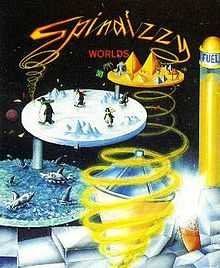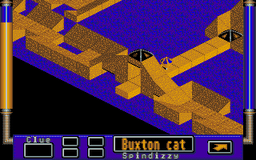Spindizzy Worlds
| Spindizzy Worlds | |
|---|---|
 | |
| Publisher(s) | Activision, ASCII Entertainment (SNES) |
| Platform(s) | Amiga, Atari ST, SNES |
| Release date(s) | Amiga 1990 Atari ST 1990 SNES |
| Genre(s) | Puzzle |
| Mode(s) | Single-player |
| Distribution | cartridge (SNES) |
Spindizzy Worlds is a puzzle video game published by Activision, released on the Amiga and Atari ST in 1990. It was later released on the Super Famicom in 1992 and the Super Nintendo Entertainment System in 1993 by Ascii Entertainment. The game is a sequel to the 1986 video game Spindizzy. Like its predecessor it uses an isometric view, and the player controls a spinning top kind of robotic device named GERALD, a Geographical Environmental Reconnaissance And LandMapping Device, that is tasked with exploring and mapping a star system before it is destroyed.
Gameplay

GERALD has limited controls only being able to move around with the use of braking and accelerating. The player must guide the device through several levels, there are many hazards enemies and puzzles based on finding and pressing switches in the correct order and navigating thin pathways without falling off. GERALD cannot jump on its own but can reach higher platforms and traverse large gaps by accelerating and jumping over ramps or using moving platforms or warps. GERALD's health, called fuel, depletes slowly over time or quicker when falling of ledges on touching enemies and hazards, it is replenished in small amounts after finishing a section of a stage and by collecting gems that are found around most levels.
To start, the level select screen has two clusters or, star systems Easy and Hard, named Easydizzy and Spindizzy in the SNES version. The harder system contains more complex level and a higher number of levels than the easier system. In both clusters planets represent levels, and although the player has a choice of which to level to play, the easier outer planets must be completed before the harder inner planets can be selected. The central star is the final stage and can only be selected after all the others are beaten. The levels are all individually named and may have a distinct visual or gameplay style.
The game was ranked the 13th best game of all time by Amiga Power.[1]
References
- ↑ Amiga Power magazine issue 0, Future Publishing, May 1991